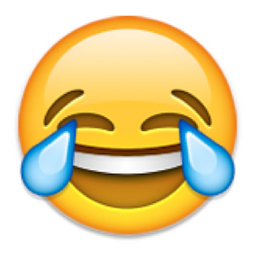What’s the big deal about Oxford English Dictionary’s 2015 Word of the Year?
For years, The Oxford English Dictionary (OED) has been publishing its Word of the Year, with lexicographers and Oxford University Press employees scrupulously reviewing the most commonly-used and up-and-coming words of the past 12 months to find their winner. With previous results including “simples” (2009) and “selfie” (2013), it’s easy to see how the winning words are reflective of the social and cultural climate of the year. This year’s winner represents happiness, something irrefutably positive and has been used billions of times in 2015 alone[1], so why has it caused such waves? It’s because it isn’t a word at all. It’s a pictograph.
The smiley face with tears of laughter emoji (![]() ©) beat entries such as “Brexit” and the singular gender-neutral pronoun “they” to the coveted crown. For some, emojis (cartoon-like images whimsically depicting everything from people to animals, from food to flags,) fit seamlessly into everyday life, feeding people’s appetite for a quick, personalised and effective method of communication. As OED themselves have pointed out, the victory of an image in the Word of the Year competition is testament to the “visually driven, emotionally expressive, and obsessively immediate”[2] demands of today’s society. For others, however, emojis are a sign of increasing communicative laziness and a regression of the English language. As the secret of holding people’s attention becomes ever more elusive, images are beginning to accompany and even replace language in our daily lives.
©) beat entries such as “Brexit” and the singular gender-neutral pronoun “they” to the coveted crown. For some, emojis (cartoon-like images whimsically depicting everything from people to animals, from food to flags,) fit seamlessly into everyday life, feeding people’s appetite for a quick, personalised and effective method of communication. As OED themselves have pointed out, the victory of an image in the Word of the Year competition is testament to the “visually driven, emotionally expressive, and obsessively immediate”[2] demands of today’s society. For others, however, emojis are a sign of increasing communicative laziness and a regression of the English language. As the secret of holding people’s attention becomes ever more elusive, images are beginning to accompany and even replace language in our daily lives.
But does the rise of the emoji really signify an apathetic society where it’s all doom and gloom for modern day language use, or should we view it rather as an optimistic sign of just how much today’s society yearns to communicate? They have been around for close to a decade, but have recently risen to prominence, escaping the exclusivity of the teenage demographic as parents publish posts on Facebook and grandparents grapple with WhatsApp.
They nevertheless continue to divide opinion, and the emoji sitting atop the OED’s 2015 Word of the Year list will no doubt add fuel to an already fiery debate. Here at The Translation People, we occupy both ends of the spectrum: some of us are avid emoji users like Andy Murray (see his word-free wedding tweet[3]), whilst others would rather stick to expressing ourselves using the comfortable refuge of the Latin alphabet. Whichever side of the fence you’re on, you won’t be alone as the emoji discussion, much like the reign of emojis themselves, shows no sign of stopping.

© Image: public domain. Oxford English Dictionary’s 2015 Word of the Year: the smiley face with tears of joy emoji
[1] Oxford Dictionaries Word of the Year 2015 is… (Oxford Dictionaries: 16th November 2015) https://blog.oxforddictionaries.com/2015/11/word-of-the-year-2015-emoji/
[2] Oxford Dictionary swaps Word of the Year for public’s favourite emoji (Hannah Furness for The Telegraph, 17th November 2015). https://www.telegraph.co.uk/news/newstopics/howaboutthat/11999230/Oxford-Dictionary-swaps-Word-of-the-Year-for-publics-favourite-emoji.html
[3] https://twitter.com/andy_murray/status/586811114744320000
